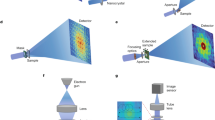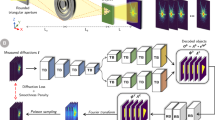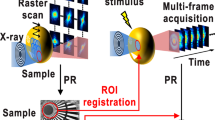Abstract
The availability of third-generation synchrotrons and ultimately X-ray free-electron lasers1 is driving the development of many new methods of microscopy. Among these techniques, coherent diffractive imaging (CDI) is one of the most promising, offering nanometre-scale imaging of non-crystallographic samples. Image reconstruction from a single diffraction pattern has hitherto been possible only for small, isolated samples, presenting a fundamental limitation on the CDI method. Here we report on a form of imaging we term ‘keyhole’ CDI, which can reconstruct objects of arbitrary size. We demonstrate the technique using visible light and X-rays, with the latter producing images of part of an extended object with a detector-limited resolution of better than 20 nm. Combining the improved resolution of modern X-ray optics with the wavelength-limited resolution of CDI, the method paves the way for detailed imaging of a single quantum dot or of a small virus within a complex host environment.
This is a preview of subscription content, access via your institution
Access options
Subscribe to this journal
Receive 12 print issues and online access
$259.00 per year
only $21.58 per issue
Buy this article
- Purchase on SpringerLink
- Instant access to full article PDF
Prices may be subject to local taxes which are calculated during checkout




Similar content being viewed by others
References
Chapman, H. N. et al. Femtosecond diffractive imaging with a soft-X-ray free-electron laser. Nature Phys. 2, 839–843 (2006).
Bates, R. H. T. Fourier phase problems are uniquely solvable in more than one dimension, 1. Underlying theory. Optik 61, 247–262 (1982).
Marchesini, S. et al. X-ray image reconstruction from a diffraction pattern alone. Phys. Rev. B 68, 140101 (2003).
Miao, J., Charalambous, P., Kirz, J. & Sayre, D. Extending the methodology of X-ray crystallography to allow imaging of micrometre-sized non-crystalline specimens. Nature 400, 342–344 (1999).
Robinson, I. K. et al. Reconstruction of the shapes of gold nanocrystals using coherent X-ray diffraction. Phys. Rev. Lett. 87, 195505 (2001).
Pfeifer, M. A. et al. Three-dimensional mapping of a deformation field inside a nanocrystal. Nature 442, 63–66 (2006).
Shapiro, D. et al. Biological imaging by soft x-ray diffraction microscopy. Proc. Natl Acad. Sci. 102, 15343–15346 (2005).
Miao, J., Sayre, D. & Chapman, H. N. Phase retrieval from the magnitude of the Fourier transforms of nonperiodic objects. J. Opt. Soc. Am. A 15, 1662–1669 (1998).
Williams, G. J. et al. Fresnel coherent diffractive imaging. Phys. Rev. Lett. 97, 025506 (2006).
Pitts, T. A. & Greenleaf, J. F. Fresnel transform phase retrieval from magnitude. IEEE Trans. Ultrason. Ferroelectr. Freq. Control 50, 1035–1045 (2003).
Fienup, J. R. Phase retrieval algorithms: A comparison. Appl. Opt. 21, 2758–2769 (1982).
Gabor, D. Microscopy by reconstructed wavefronts. Proc. R. Soc. Lond. A 197, 454–487 (1949).
Walton, A. J. The Abbe theory of imaging: An alternative derivation of the resolution limit. Eur. J. Phys. 7, 62–63 (1986).
Williams, G. J., Quiney, H. M., Peele, A. G. & Nugent, K. A. Coherent diffractive imaging and partial coherence. Phys. Rev. B 75, 104102 (2007).
Rodenburg, J. M. et al. Hard-X-ray lensless imaging of extended objects. Phys. Rev. Lett. 98, 034801 (2007).
Spence, J. C. H., Weierstall, U. & Howells, M. Coherence and sampling requirements for diffractive imaging. Ultramicroscopy 101, 149–152 (2004).
Zuo, J. M. et al. Atomic resolution imaging of a carbon nanotube from diffraction intensities. Science 300, 1419–1421 (2003).
Quiney, H. M. et al. Diffractive imaging of highly focused X-ray fields. Nature Phys. 2, 101–104 (2006).
McNulty, I. et al. A beamline for 1–4 keV microscopy and coherence experiments at the Advanced Photon Source (APS). Rev. Sci. Instrum. 67, 3372 (1996).
Acknowledgements
We acknowledge L. Whitehead for assistance in acquiring optical data. We also acknowledge the support of the Australian Research Council Centre of Excellence for Coherent X-Ray Science and the Australian Synchrotron Research Program. Use of the Advanced Photon Source was supported by the US Department of Energy, Office of Science, Office of Basic Energy Sciences, under contract No. DE-AC02-06CH11357.
Author information
Authors and Affiliations
Contributions
B.A., G.J.W., J.N.C., M.A.P., M.D.J. and I.M. made the X-ray measurements. B.A. carried out visible light experiments. B.A. and G.J.W. were responsible for data analysis and project planning. K.A.N., G.J.W. and A.G.P. were responsible for the initial concept. All authors contributed to the writing of the manuscript.
Corresponding author
Supplementary information
Supplementary Information
Supplementary Figure 1 (PDF 2176 kb)
Supplementary Information
Supplementary Movie (MOV 1953 kb)
Rights and permissions
About this article
Cite this article
Abbey, B., Nugent, K., Williams, G. et al. Keyhole coherent diffractive imaging. Nature Phys 4, 394–398 (2008). https://doi.org/10.1038/nphys896
Received:
Accepted:
Published:
Issue date:
DOI: https://doi.org/10.1038/nphys896
This article is cited by
-
Scalable and accurate multi-GPU-based image reconstruction of large-scale ptychography data
Scientific Reports (2022)
-
Plasmon-induced enhancement of ptychographic phase microscopy via sub-surface nanoaperture arrays
Nature Photonics (2021)
-
Dynamic nanoimaging of extended objects via hard X-ray multiple-shot coherent diffraction with projection illumination optics
Communications Physics (2021)
-
In situ coherent diffractive imaging
Nature Communications (2018)
-
A fast-converging iterative method based on weighted feedback for multi-distance phase retrieval
Scientific Reports (2018)



